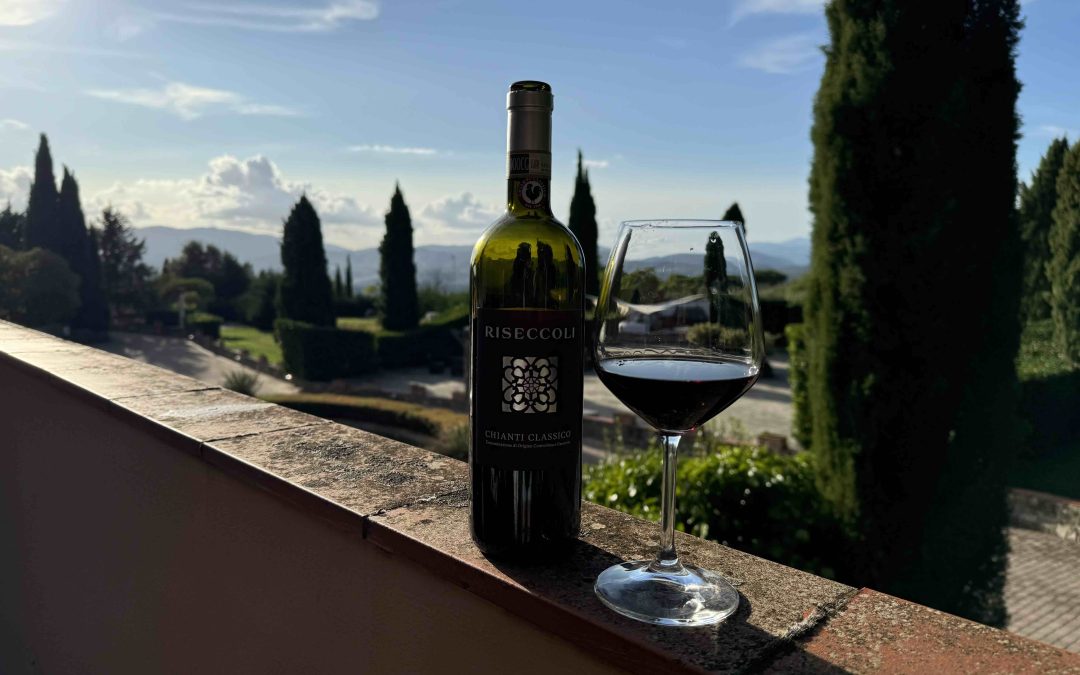This post contains affiliate links.
Chianti Classico is produced exclusively in Chianti Italy, a region of Tuscany. As fans of Chianti wine, we wanted to visit the source. We were in Italy after all, in the heartland of Tuscany, between the provinces of Florence and Sienna, where Chianti wines originate.
Riseccoli winery
Riseccoli winery, a family-owned sustainable winery close to Greve, was our first authentic Chianti wine experience in Italy. Ambling through the rolling hills of Tuscany in our rental car late September, we chose it for no particular reason, other than it appeared open, and didn’t look busy.
Turns out we happened upon one of the regions premiere wineries, at an unlikely quiet time.

Prior to sampling wines, our host encouraged us to have a look around the property and enjoy the stunning countryside surrounding the estate.

Lush vine covered rolling hills, soft valleys, olive groves, and century old cypress trees lined the landscape. That hot day in September with a gentle breeze charming us as we walked the vines bursting with fruit, ready for harvest.

It was just us and an older Dutch couple partaking in the tasting. Although we had dropped by without a pre-booking, we had somehow managed to catch the proprietor before a bus tour group later in the day. She assured us walk ins were welcome. In fact she appeared grateful for gracious and appreciative guests. With the place to ourselves, a relaxed pour, the vintner shared stories between sips of wine. The only sound interrupting the chill soundtrack was a vocal rooster, strutting his stuff out back.

The Black Rooster
“That’s an impressive black cock,” stated the Dutch lady, with the confidence of having seen it for herself. Struggling to not laugh at the unintended English slang reference, and knowing full well she was referring to the rooster, I replied in an equally flat factual tone, “Yes. Yes it is.” I had also seen the black rooster. He was quite something, strutting confidently with bold purpose around the enclosed pen. A virile male of strength and presence, he was indeed quite large.

As the wine and stories flowed, we discovered the significance of the black rooster displayed proudly on the label of every Chianti wine, as a Black Cockerel seal. We would also learn why the bird’s assertive presence graced absolutely every winery in the region.

Origin of the Black Cockerel label
Our host explained that back in 1260 there was a battle for the Chianti Italy region between the Guelphs and the Ghibellines. The Guelphs were prominent in Florence and the Ghibellines held power in Siena. History has it that the men from Siena woke earlier due to a black rooster call, so they got to the region first and defeating the Florentines. As a gesture to the victorious battle call of the Black Cockerel, wineries in the region who produce Chianti, sport the historic coveted Black Cockerel Seal. Only Chianti wines produced in the region are allowed to do so by law.

The DOCG designation
In 1960, Chianti Classico became the first DOCG (Denominazione di Origine Controllata e Garantita), which translates to “Controlled and Guaranteed Designation of Origin.” For Italian wine, this classification signifies the most stringent production standards and rigorous quality controls. DOCG wines are also known for geographic specificity and unique labeling.

We sampled two reds (Sangiovese and Canaiolo) and two whites (Malvasia and Trebbiano) and several Chianti Classico varieties from the Rinascita range for everyday drinking, and several from the Riseccoli collection, the wineries top-end estate wines. Exquisite, smooth and bursting in flavor, there’s something magical about sipping wine immersed in the actual area it has been harvested from, while speaking to the proprietor who harvests, processes and bottles the product. All wines at Riseccoli are produced with an artisan approach to wine making through certified organic practices respectful of the soil and beautiful Tuscan countryside.

Riseccoli estate winery is an expression of the quintessential beauty of Tuscany. Rolling hills planted with vines and olive trees. Mediterranean forests and farmhouses scattered against an idyllic backdrop. The whole scene felt seemingly lifted from a Renaissance painting.
Departing with a bounty of wine, and enough time for our host to refresh the scene for her incoming tour bus group, we spent the balance of the day visiting a local market to retrieve some local cheeses and charcuterie, for later at our Tuscan villa deck. And then stopping to sketch in the Tuscan countryside. Could there be anything more authentic than tapping the creative urge to sketch, then sampling local fare while sipping wine with a setting Tuscan sun?
Sketching in Tuscany
Perhaps it was the Rennaisance painting inspiration, or simply the relaxed creativity stirred by the region while sampling wine, but on our way back to our villa, we stopped so I could do some sketching in the little village of Casole. The perfect creative compliment to the day, I spent part of the afternoon unrushed with pencil and sketch pad, simply observing intently and recording the nuances of the countryside which produces these remarkable wines.
In an era of instant gratification photos and social media posts for engagement, the act of slowing down to manually record the experience, became part of the treasured memories from this Chianti Italy region.
Two drawings. Two views. One location.
I captured the first sketch looking out over fields of planted vines. Parallel rows climbing horizontally across the varied rolling hills patterns. Layers faded in colour intensity as they drew more distant to the horizon. Ancient cypress trees appeared batched, interrupted periodically with homestead structures, delineating ownership of the large swaths of land. I reached out and touched the vines in the foreground as I sketched. I tried to connect the bark texture with the course strokes of my pencil. The sound of church bells chiming from distant villages was audible periodically as I sketched.

The second image is of what was behind me as I looked out over the rolling hills of vines in the first image. A country road cut extremely close to this house, as it made a sharp bend. But the road appeared of little danger, since vehicle traffic was sparse. We had stopped at the top of a hill outside the village of Casole. The warm breeze carried a sweet fragrance of fruit mixed with the smell of fertile soil. Earthy, pungent and alive.

It’s not only what you see and record on paper when sketching. It’s what you feel, smell, touch and hear that also leaves an impression of the place. Sketching is a window that intensifies awareness. Senses come alive when you slow long enough to create the space. Tuscany and Chianti Italy had a way of doing that.
Driving the Tuscan hills in Chianti Italy
Driving through Tuscany can be scenic and relaxing, or stressful and directionally challenging, depending on the circumstances. While this day was quintessential Tuscan chill, the previous day getting to the Tuscany region from Pisa required patience.
Our rental car had wanted to speak Italian, and despite multiple attempts to reset Google Maps to English, our navigation system proved charming but useless. It’s remarkable we eventually found our Italian villa in the Tuscan hills at all. Rolling up in the dark, having finally cracked the code on English in Apple Maps using a cell phone not connected to the car, the rattling experience of navigating tight unfamiliar roads in dying daylight took its toll.
The next day we got our smooth talking Italian car sorted, and we eventually found a superior route through Regello for the return to our villa, via a marginally longer route. Driving the narrow and twisty roads of rural roads of Tuscany is half the experience though. Learning more Italian than we had might have come in handy to communicate with the rental car!
Tuscan villas
Tuscan villas come with a unique history rooted in the Renaissance period. Villas were originally a country house retreat for the wealthy, designed for seasonal pleasure, located an easy distance from the city. Many Tuscan villas have been preserved, or adapted as bed and breakfasts, hotels, or private residences. No visit to Chianti Italy, and the Tuscany region, is complete without staying in a historical Tuscan villa.

Our villa was just as fabulous as the online booking photos promised. The place was actually an entire home space, with living area, two bedrooms, bathroom, full kitchen and private patio, facing west for sunset. Our ground floor made it feel more like a private residence.

The Fattoria degli Usignoli villa property has multiple villas, located in 15th century farm buildings. The outdoor loggia and park compliment the pool and lounge area.

The property also has a restaurant on site serving a vast selection from traditional Tuscan and contemporary cuisine. As evidenced by the parking lot and the restaurant’s booked up reservations, the restaurant’s popularity reaches far beyond guests at the property.

Fattoria degli Usignoli was built by the monks of Vallombrosa in the 15th century. (Honestly, when is the last time you slept somewhere built in the 15th century? Let that sink in! The villa is located close to the town of Reggelo, on the slopes of Pratomagno massif. Roberto Tozzi, the General Manager, was our host at this historic property. Check availability at Fattoria degli Usignoli villas here.
Inside our villa




Fattoria degli Usignoli looks out over the marvelous Valdarno and Chianti landscapes. The location is a great staging point for visits to Tuscany’s major art cities – Florence, Siena, San Gimignano, Arezzo, Certaldo, Corona, and the entire Chianti region.
Our perfect day in Tuscany concluded with a bottle of Chianti Classico from Riseccoli winery, sipped and savored on the deck of our villa. It was just the way I envisioned when we booked.





Accommodations in Tuscany
Tuscany has multiple villas in the region. Although I’m partial to the fabulous experience we had at Fattoria degli Usignoli, there are many other choices you may wish to consider. Use this map and accommodation guide to refine your search.
More content from Italy
Saturnia Hot Springs in Italy: How to avoid crowds
When Language Knows No Barrier to Friendship: An Italian family dinner in Tuscany


